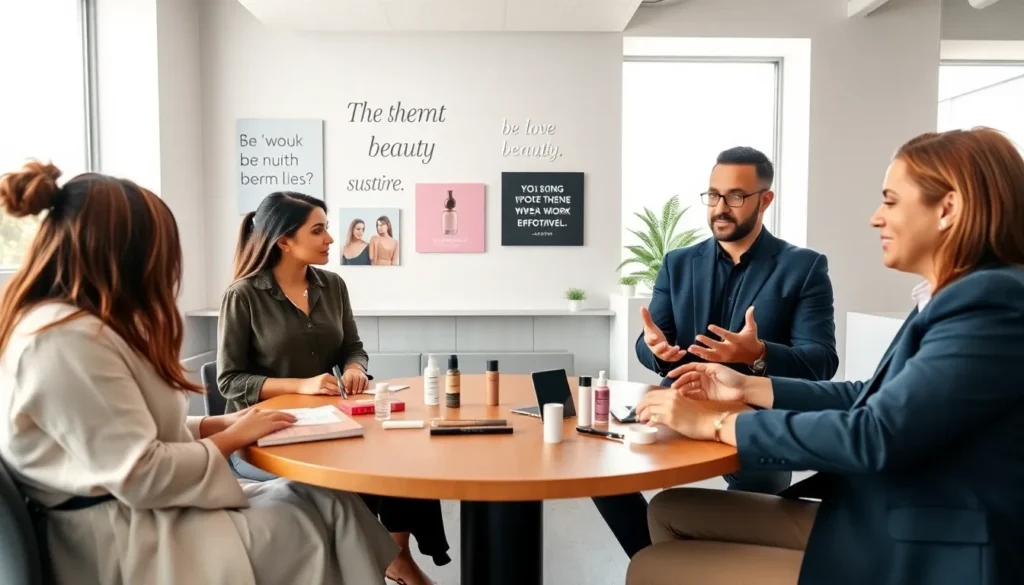Table of Contents
ToggleThe beauty industry isn’t just about looking good: it’s a multi-billion dollar powerhouse that influences culture, trends, and even economics worldwide. With endless products promising to make one feel fabulous, it’s no surprise that this industry is constantly evolving. But have you ever wondered about the key players and trends shaping this vibrant world? Or how regulations impact beauty brands and the challenges they face? Strap in, because this exploration will be both insightful and entertaining, shedding light on the intricacies of the beauty industry group that keeps us all glowing.
Overview Of The Beauty Industry

The beauty industry is a vast realm comprising various sectors, including cosmetics, skincare, haircare, and fragrances. This industry is often referred to as the ‘$500 billion beast’ – a term that reflects its sheer scale and economic impact. Each year, consumers worldwide spend staggering amounts on beauty products, from everyday skincare essentials to luxury brand indulgences.
Within this expansive industry, beauty isn’t a superficial pursuit: it acts as a form of self-expression for many. People invest in products that reflect their identities, aspirations, or even their moods. The beauty industry’s growth is frequently spurred by societal influences, pop culture, and innovative marketing strategies, making it as much about creativity and connection as it is about commerce.
Key Players In The Beauty Sector
When diving into the beauty industry, one quickly encounters both established giants and innovative newcomers. Companies like L’Oréal, Estée Lauder, and Procter & Gamble have become household names, dominating the commercial landscape with their extensive product lines.
Yet, it’s not just the big players that drive the industry forward. Niche brands such as Glossier and Fenty Beauty have disrupted traditional norms by focusing on inclusivity and social media engagement to connect with consumers. Brands like these often highlight the shift in consumer expectations, where transparency, authenticity, and communication play crucial roles.
Also, there is an ever-increasing emphasis on diversity in product offerings. From shades of foundation catering to a wider spectrum of skin tones to gender-neutral fragrances, beauty brands are increasingly moving beyond traditional boundaries to embrace a more inclusive approach.
Trends Shaping The Beauty Industry
The beauty industry is in constant flux, with trends shaping its future at every turn. One prominent trend is the rise of clean beauty, a movement focusing on toxin-free, natural ingredients. Consumers are becoming more discerning, often opting for products that are not only effective but also ethical.
Social media platforms also play a pivotal role in shaping trends. Influencer marketing and viral challenges have taken the industry by storm. Brands now leverage these networks to reach audiences in innovative ways, creating beauty tutorials or challenge videos that engage consumers and encourage product discovery.
Another significant trend includes the personalization of beauty. Artificial intelligence is being harnessed to analyze individual needs and preferences, allowing brands to tailor products specifically for unique skin types or concerns.
Regulations Impacting Beauty Brands
Navigating regulations is a critical aspect of operating in the beauty industry. These rules ensure consumer safety and product effectiveness. The FDA, for example, oversees cosmetics manufactured in the U.S., establishing guidelines that brands must follow about ingredient safety and labeling.
In Europe, regulations are even stricter. The EU bans several harmful substances that are still permitted elsewhere, pushing brands to reformulate their products for compliance. This can be a challenging job, especially for smaller brands that may lack the resources to navigate the complex regulatory landscape.
These legal stipulations significantly impact how brands market their products and interact with consumers. Non-compliance can lead to severe penalties, making it essential for beauty brands to stay informed and adaptable.
Challenges Facing The Beauty Industry
Amidst the glamour and glitz, the beauty industry faces prominent challenges that require keen strategic thinking. One such issue is the saturation of the market. With countless brands vying for attention, distinguishing oneself has never been more challenging. This competition forces brands to innovate constantly, pushing them to evolve and adapt quickly.
Another significant challenge is the impact of global crises, such as the COVID-19 pandemic, which triggered major disruptions in supply chains and consumer purchasing habits. As consumers turned to e-commerce, beauty retailers were forced to change their strategies overnight, with a greater emphasis on online sales channels.
Also, managing sustainable practices has gained urgency. Brands are under pressure to minimize their environmental footprint while meeting consumer demands for eco-friendly products.
The Role Of Sustainability In Beauty
In recent years, sustainability has become a centerpiece in discussions surrounding the beauty industry. Environmentally-conscious consumers are increasingly favoring brands that prioritize ethical practices, from sourcing ingredients to packaging. Many companies are re-evaluating their supply chains to ensure they align with sustainable values, such as using recyclable materials and ethical sourcing.
Brands like Lush have taken bold steps, rejecting conventional packaging in favor of solid products or reusable containers. This shift not only appeals to eco-conscious consumers but also establishes brands as forward-thinking leaders in the industry.
The integration of sustainability is not merely a fleeting trend: it represents a fundamental shift in how beauty brands operate. As consumers continue to prioritize sustainability, brands must embrace these values or risk falling behind.







